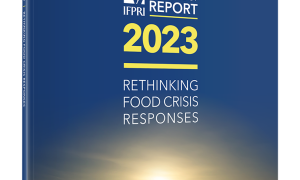Food systems and diets underpin many critical challenges to public health and environmental sustainability, including malnutrition, noncommunicable diseases, and climate change, but sustainable healthy diets have the unique potential to reshape th
Search
Limited access to reliable financial instruments makes it difficult for rural households to manage daily cash flows. Selling goods through cooperatives can improve savings, but cooperative income is not easily accessible when facing an emergency.
This paper reports on a randomized experiment conducted among Malawian agricultural households to study nonclassical measurement error (NCME) in self-reported plot area, and farmers' responses to new information — the objective plot area measure —
Random digit dial surveys with mobile phones risk under-representation of women. To address this, we compare the characteristics of women recruited directly with those of women recruited through referrals from male household members.
لقد واجه العالم الكثير من الازمات خلال عام 2022.
En 2022, el mundo se enfrentó a múltiples crisis.
En 2022, le monde a subi des crises multiples.
2022年,世界面临多重危机。旷日持久的2019冠状病毒病疫情(COVID-19)、重大自然灾害、内乱和政治动荡以及气候变化日益严重的影响对食物系统的破坏仍在继续,而与此同时,俄乌战争和通货膨胀加剧了全球粮食和化肥危机。危机数量不断增加,多种危机的叠加影响日益加剧,饥饿人口和流离失所者数量不断攀升,促使人们呼吁重新思考粮食危机应对措施,从而为变革创造了一个真正的机会。
In 2022, the world faced multiple crises.
Agrifood value chains in the world’s low- and middle-income countries (LMICs) have expanded rapidly over the past decade, supplying an increasing volume and diversity of food products.
Recent global crises have led to diverse impacts across the world’s low- and middle-income regions, reflecting local conditions and differing policy responses.
Over the past two decades, social protection programs have become a mainstream policy tool to address chronic poverty and food insecurity in low- and middle-income countries (LMICs).
Global and national agrifood systems are vulnerable to a variety of shocks that have caused major disruptions to food production, markets, and livelihoods over the past two decades, and have set back efforts to reduce poverty, food insecurity, and
In human, economic, and environmental terms, the total cost of disaster and crisis response is extremely high, and the disastrous combination of the food price crises coming on the heels of the COVID-19 pandemic and natural calamities is straining
In 2022, the world faced multiple crises.
Now is the time to rethink how we address food crises. Better prediction, preparation, and resilience building can make future crises less common and less devastating, and improved responses can contribute to greater food security, better nutrition, and sustainable livelihoods
Gender inequality exists everywhere, but it is particularly stark in fragile and conflict-affected settings (FCAS).
Migration is a recurrent, complex, and multidimensional phenomenon driven by a broad set of factors.
Addressing public health externalities often requires community-level collective action. Due to social norms, each person’s sanitation investment decisions may depend on the decisions of neighbors.
Measuring consumption over the phone: Evidence from a survey experiment in urban Ethiopia
The paucity of reliable, timely household consumption data in many low- and middle-income countries have made it difficult to assess how global poverty has evolved during the COVID-19 pandemic.

